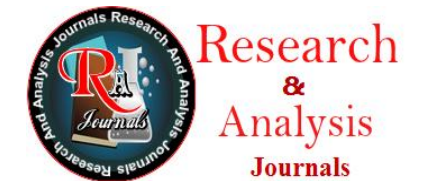A Study to Assess the Association of Acanthosis Nigricans with Metabolic Syndrome and Its Individual Parameters: A Case-Control Descriptive Study from Tertiary Care Hospital
Downloads
Background: Acanthosis nigricans (AN) is characterised by hyperpigmented, dark, rough, velvety plaques, typically on the intertriginous areas and neck. AN could be a marker of underlying metabolic syndrome (MetS). Various parameters of MetS include hypertension, hyperglycemia, low high density lipoprotein (HDL) cholesterol, high waist circumference (WC) and hypertriglyceridemia.
Aim: To determine the association between the acanthosis nigricans and parameters of metabolic syndrome.
Material & Methods: This study was a descriptive case-control study conducted over a period of 1 year. Fifty-five patients of AN and 55 age and sex matched controls were included to asses the association between AN and MetS parameters.
Results: Out of 55 cases of AN evaluated, 45.5% had MetS of which 58.2% were males and 41.8% females. Among the cases, 76.36% had increased WC, 36.36% had hypertension, 45.45% had elevated triglycerides, 63.63% had decreased HDL and 27.27% had increased fasting blood sugar levels. The Association of AN and MetS was found to be highly significant in the study population (p<0.001).
Conclusion: Our study concluded that AN patients had elevated individual components of MetS. Hence, presence of AN could be a marker of underlying MetS. Primary healthcare workers in resource poor settings should be trained to identify AN, and to asses for individual components of MetS so that, early diagnosis can be made and treatment should be started.
Elias LL, Clark AL. The molecular basis of adrenocorticotrophin resistance syndrome. Prog Mol Biol Transl Sci. 2009;88:155-71. doi: 10.1016/S1877-1173(09)88005-8. Epub 2009 Oct 7. PMID: 20374727.
Melnik BC. Permanent impairment of insulin resistance from pregnancy to adulthood: the primary basic risk factor of chronic Western diseases. Med Hypotheses. 2009;73:670-81.
Puri N. A study of pathogenesis of AN and its clinical implications. Indian J Dermatol. 2011 Nov;56:678-83.
Kahn C.R.Flier J.S.Bar R.S.Archer J.A.Gorden P.Martin M.M.et al. The syndromes of insulin resistance and AN: insulin-receptor disorders in man. N Engl J Med. 1976; 294: 739-745.
Sinha S, Schwartz RA. Juvenile AN. J Am Acad Dermatol. 2007;57:502-8.
Jeong KH, Oh SJ, Chon S, Lee MH. Generalized AN related to type B insulin resistance syndrome: A case report. Cutis. 2010;86:299–302.
Philip NE, Girisha BS, Shetty S, Pinto AM, Noronha TM. Estimation of metabolic syndrome in AN - A hospital based cross-sectional study. Indian J Dermatol, 2022;67:92.
Venkatswami S, Anandam S. AN: a flag for insulin resistance. J Endocrinol Metab Diabetes S Afr. 2014;19:68-74.
Patidar PP, Ramachandra P, Philip R, Saran S, Agarwal P, Gutch M, et al. Correlation of AN with insulin resistance, anthropometric, and other metabolic parameters in diabetic Indians. Indian J Endocrinol Metab. 2012;16;:436-7. .
Prasad DS, Kabir Z, Dash AK, Das BC. Prevalence and risk factors for metabolic syndrome in Asian Indians: A community study from urban Eastern India. J Cardiovasc Dis Res 2012;3:204–11.
Third report of the National cholesterol Education Program (NCEP) expert panel on detection, evaluation, and treatment of high blood cholesterol in adults (Adult treatment panel 111) final report. Circulation 2002, 106:3143-421.
Choudhary S, Srivastava A, Saoji V, Singh A, Verma I, Dhande S. Association of AN with metabolic syndrome – an analytic cross-sectional study. An Bras Dermatol. 2023,,ISSN 0365-0596. doi: 10.1016/j.abd.2022.07.006, PMID 36964104.
Ayaz T, Baydur Şahin S, Şahin OZ. Relation of AN to metabolic syndrome in overweight and obese women. Metab Syndr Relat Disord. 2014 Aug;12(6):320-3. doi: 10.1089/met.2013.0145.
Shah NG, Khatu SS, Gokhale NR, More YE, Khismatrao D. AN: a cutaneous marker for metabolic syndrome. Med J DY Patil Vidyapeeth 2019;12: 16–21. Kluczynik CE, Mariz LS, Souza LC, Solano GB, Albuquerque FC, Medeiros CC. AN and insulin resistance in overweight children and adolescents. An Bras Dermatol. 2012;87:531–7.
Copyright (c) 2025 Dr. Nazia Bano, Dr. V. Rao Koti, Dr. Savita Chaudhary, Dr. Moin Ahmad Siddiqui

This work is licensed under a Creative Commons Attribution 4.0 International License.
All Content should be original and unpublished.



